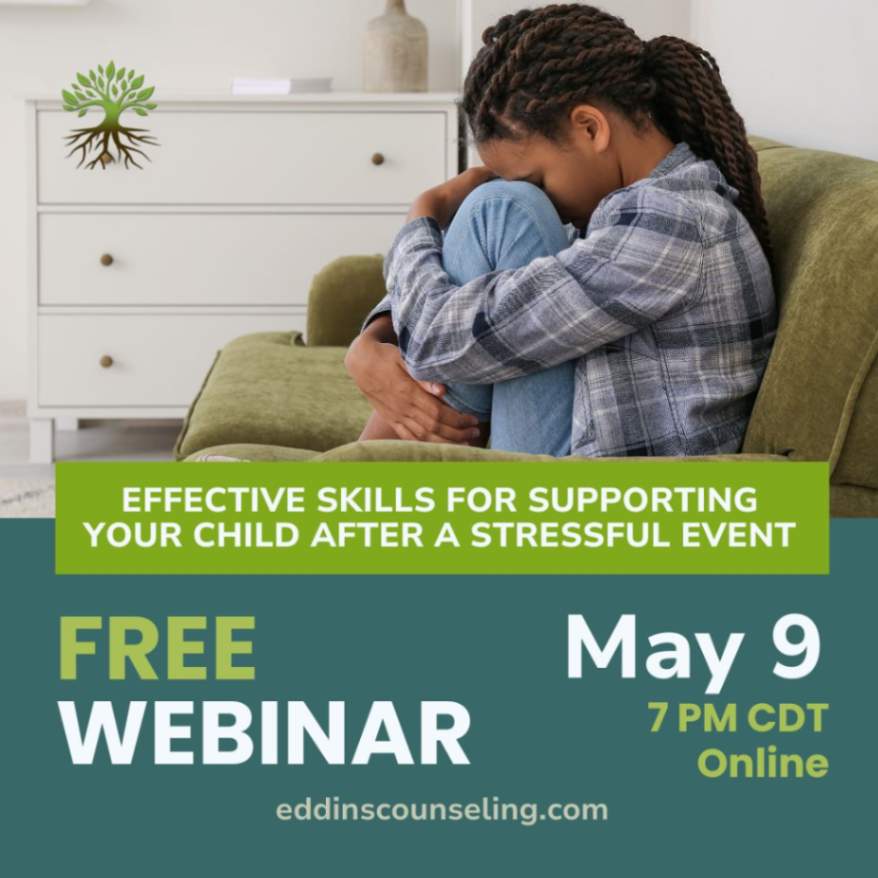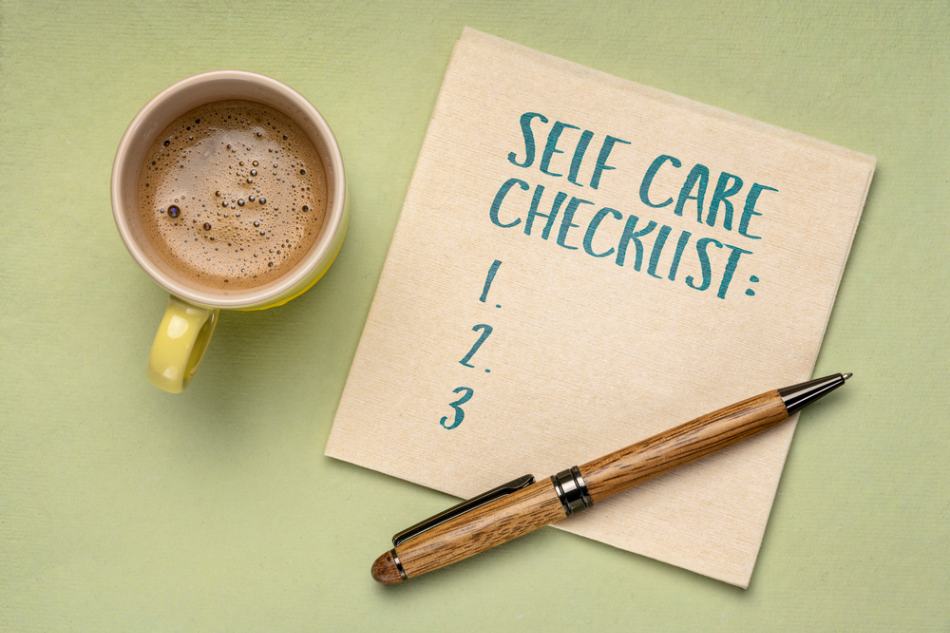April 20, 2021
Webinar: How to Support Your Teen and Create Healthy Boundaries
Written by Rachel Eddins
Posted in Parenting & Family, Teen Counseling, Webinars and with tags: Communication, family, teens

Navigating a relationship with a teen can be challenging, stressful, and confusing.
We want to be able to have trust in our teens, hold them accountable, and feel that they can come to us with challenges.
In this workshop, we will learn how to have open communication with your teen and look at healthy boundary settings.
Facilitated by Marcie Dinkin, LCSW.
Learn more about individual therapy for teens, group therapy for teens, DBT skills groups for teens, and DBT skills groups for parents of teens.

Hello, I’m Marcie Dinkin
My name is Marcie Dinkin. I am a licensed clinical social work supervisor. I work at Eddins Counseling Group working primarily with teenagers, young adults, and families, doing some individual therapy, and some family therapy. I also run a Parenting Dialectical Behavior Therapy support group, which will run for eight weeks. It’s going to be Fridays from twelve to one on Zoom. It’s kind of like a lunch-and-learn – ways to kind of get some support and also learn some DBT at the same time that maybe would be helpful in communicating with your team or kind of for yourself. For example,
- “How do I want to regulate myself when somebody else around me also seems a little bit kind of dysregulated?”
- “How do I make sure I don’t get into their emotional stuff?”
- “How do I hold my own end and take care of my needs?”
It’s like they say on an airplane: you put on your own oxygen mask on first before putting on somebody else’s.
I’m going to talk today about:
- what are boundaries,
- how to have helpful communication,
- and what can also be the struggles of raising a teen or a young adult that feels resilient
- while also figuring out how to co-parent and see “what’s my stuff, what’s their stuff,” and
- how to not engage in a split while feeling unified at the same time.
Navigating Boundaries with Teens
Everyone has their own definition of what comes to mind when thinking of a boundary.
That probably sounds like a boundary. Limits. Personal space. Saying, “I don’t want people necessarily in my bubble.” A boundary takes into account another person’s willingness to tolerate and understand the rules of a relationship.
Personal Boundaries Exercise
Knowing the importance of boundaries, here are some questions to ask yourself:
- What are my non-negotiables
- What am I willing to hold as a limit?
- What am I not willing to hold?
- When you think of setting a boundary, what different challenges come to mind?
The Dreaded Toxic Boundary Cycle
Maybe it feels like you’re stuck in a cycle to keep spinning the wheel until someone gets what they want. And then you feel like you’re run down to the point where you compromise your boundary. That sounds like the definition of insanity.
As boundaries are discussed, examples can come to mind when thinking about a boundary struggle.
This could be a relationship you don’t want to deal with. Oftentimes, family members can respond with a behavioral reaction that makes you feel like tiptoeing on eggshells around them because it becomes challenging. You don’t want to deal with their reaction and their explosiveness.
Some things are non-negotiable that each one of them wants to make negotiable. And most of our rules here are about helping them become decent human beings. My mom used to joke with me, I have one job to keep you off the pole and out behind the bars.
The issue is our rules are not technically strict rules. They’re basic boundaries around things. There are time limits for screen time. There are basic chores to be completed.
Does this Sound Familiar?
Listen in as a mom describes her experience parenting with boundaries with teens and young children:
“And what I get when I push back is that it hasn’t been done – or I’ve had to tell you two or three times to do it. At that point, it becomes an excuse. There’s always an excuse, and it’s frustrating to have the 16-year-old do that in front of the ten-year-old and four-year-old because then it becomes a compounded problem. And my only patience I have is with my children. So I reserved that for them and they’re still push, push, push, push, talk back. And by the time you get to 10:00 at night, it’s just like, go to bed, just go to bed. I can’t do this anymore today. Just go to bed. And so that’s what we deal with around here and it’s exhausting.”
You’re right mom, it is exhausting! And that becomes the definition of insanity where you’re just doing the same thing over and over again, but it doesn’t feel like you’re getting any different kind of result. In this situation, I would challenge you to ask yourself, “What do you think gets in the way of keeping a boundary?”
We want to be open in our communication with our children. However, it is important to foster respect from both sides. If you’re getting negative pushback in a non-respectful way, it may be helpful to say something like,
“We have a window and if you approach me without respect I’m probably going to respond in a very disciplinary kind of parenting, but it doesn’t have to be that way. These are times when we will talk about this. If it is outside of that window, I’m not willing to engage in this power struggle with you. I love you.”
Are Boundaries Even Worth the Headache?
When making boundaries, what you’re actually doing is shaping their behavior. It may feel like when your child became a teen, all of that influence you had flew out the window. But with boundaries, you have a very real opportunity to mold your teen into the adult you want them to be.
When you hold a boundary, the key is to reinforce it like nobody’s business.
“Mandy, you did such a good job! Thank you so much.”
It’s all about consistency. If they do something you don’t like, you may be tempted to ignore it and just let them do what they want to do. Maybe they can throw a temper tantrum. The 16-year-old can throw things, or break things. No matter the behavior, holding a boundary ensures that the child is going to have consequences. And that’s their choice. And so when you think about holding a boundary, it’s helpful to remind yourself that it’s going to get worse potentially before it gets better.
You can also use your teen’s behavior as an opportunity for leadership. Have a conversation with your teen and ask hard questions like:
- “How do you want to kind of demonstrate healthy communication for your younger siblings?”
- “Is that how you would talk to a friend?”
- “You’re a role model for your younger siblings. I appreciate it when you ______________.”
You’re also demonstrating a parallel process of how your teen can act at home. This in turn parallels their relationships outside of home.
Setting Boundaries 101
When starting out with healthy boundaries, it’s important to consider your own feelings. It may be difficult to set rules for behavior.
Listen in as Nikki describes her internal struggle making boundaries with her chronically ill teen:
Nikki
‘I’ve struggled because my 14-year-old has had chronic illness his entire life. And life finally got kind of normal when he turned twelve. And then this fall, he was diagnosed with brain cancer and had brain surgery. They cut them open and cut out his tumor. And he was out of school for a couple of months and is now slowly coming back.
But he was an avid skateboarder and doesn’t want to skate with a helmet. So we said, “Well, we’re pretty sure you need to wear a helmet, but let’s see what the neurologist said.” And the neurologist required him to skate with a helmet. But my son didn’t want that. He still refuses to wear the helmet. But it’s his only form of exercise. It’s his only form of socialization.’
Marcie & Lisa
If we put ourselves in his shoes: not wearing a helmet is his way of having power and control. Everything in my life has been decided for me. I’m just validating that need for autonomy. And doctors are telling me what to do and my body is doing what it wants to do. Even my parents.
And simply put, I don’t want to wear a helmet.
It may be hard to be firm when you want him to have that kind of autonomy in his life. The main point being, we want you to be alive. Therefore, if this is what you need to do, we’re just going to do it. Keeping consistent with this kind of boundary could involve positive reinforcement, saying things like:
- I saw you wear your helmet today. Great job!
- Thank you for being safe today – remember your helmet.
- Since you’ve worn your helmet every day this week, we’d like to take you to the new skateboard park up town.
- Your neurosurgeon is going to be really impressed with you!
Avoiding the Power Struggle
Sometimes at a younger age (6-8), children just need to be clear on the behavior required with a boundary.
But oftentimes, teenagers are ready for a fight.
And this is why boundaries are so hard. Because it’s painful to feel like you’re in this power struggle – fighting between two strong minds and personalities. It’s important to avoid getting sucked into that power struggle in the first place. Catch those early signs, and ask yourself:
- What do I want?
- What does my teen want?
- What does my spouse want?
- Are we going to be involved in the boundary decision-making?
- How do we handle getting pulled apart by teens in our parental styles?
A pro tip is to stick together like glue. Our guest Nikki and her spouse agreed long ago that they were going to be on the same page. That’s not happening at their house.
Making Boundaries Stick
According to experts, it’s also about trust.
Boundaries can be exhausting and they’re hard to hold, but it’s also essential to any relationship. Like all parents, you may be tempted to wonder,
“What’s going on with my teen and my young adult? I want to know what’s going on. But I also want to hold a boundary where they feel like they can have their own space in their life. But I also want to be supportive. And I want to make sure they’re making the right choices and doing the right thing. I’ve got to let them go and be independent.”
You’re not alone. It’s a very hard balance between trust and discipline.
And that’s what makes this so difficult is that sometimes we want to do fun things with our kids. We travel, we go places, we do things. And so when you take your kids to Disney, you want your 16-year-old to be able to wander by himself.
Setting boundaries in a relaxed way with teens
Setting boundaries can still happen in a more relaxed way if applicable. For example, because he has a phone, he can meet up at a certain time, check in from time to time, or other similar things.
But if I don’t communicate that expectation before we go, how can we allow that major responsibility if we don’t have that trust? That trust is so big that if we don’t have that, how can I let you go knowing you’re going to be okay? And this is where we falter.
I want what I want back, but it’s important to remember that’s not the reality of the situation at all, because our children haven’t learned anything. The question then becomes, how do you get those lessons to stick without being the butthead all the time?
Here are some tips for getting healthy boundaries deeply set in your teen:
- Avoid yelling or heated conversations
- Make expectations clear (eg. “I expect that I only tell you once to do _______”)
- Foster responsibility with freedom
- Build trust as you see boundaries being respected
- Allow for privileges & positive reinforcement for healthy boundaries
Can I Trust My Teen?
So trust is a big deal around here, and it’s a conversation we have because that’s the foundation of any relationship – relationships can grow from that level of respect.
Trust is an essential building block for more responsibility. They want the car. They want the freedom. But when we can’t trust them to walk the dog for 30 minutes in the morning, how can we trust them to drive something that can kill someone else.
Personal Trust Exercise
Trust and boundaries can go together like peanut butter and jelly. Take time to consider:
- How do you define trust?
- Trust looks different for different people.
- Is it something that you observe?
- Is it something that you hear?
- Is it based on behavior?
- What are things that you look for to know ‘Oh, I can trust. Okay, we have what I hear.’
How to Hold Your Teen Accountable
Trust can also come with a sense of independence and freedom. You want to give a little bit of slack on the leash to see what can happen. The process of adding slack can also give some data on how well your teen can hold a boundary.
It’s a delicate balance because you don’t want to be a helicopter parent, tracking every move. Because you also want to have trust. But also, I imagine if trust feels like it’s broken, then the boundaries feel much more kind of constrained and constricted.
Parent Perspective
“At our house, it’s really about lying and, accountability. So if you did mess up, there’s a lot of consistent lying instead of just owning it and saying, I did it either on purpose or not on purpose, and I’m sorry, and how do we make it better?”
In recovery, they say sometimes it’s your secrets that keep you sick. Sometimes we feel like we can get away with certain behavior versus being held accountable and having to deal.
Sometimes the most powerful thing a parent can say or a caregiver is, “I feel disappointed when you did ________” or even “You hurt my feelings when you did _________”.
I can’t tell you how many times I hear a client come in and say “My mom said they were disappointed, it just crushed me.” It’s terrifying sometimes to say how we feel and what we need, and yet it’s also such a powerful tool when asserting your boundary. What you’re really saying is that it really hurt your feelings when your teen broke your trust.
It’s then important to follow up with next steps.
Say something like, “This is what I’m going to need from you as far as a boundary. I’m going to need a little bit of space to think about what I want to do. I want you to think about what you feel like your appropriate consequence should be based on your action, and we’ll come back together.”
Communication is Key
Holding mature conversations builds a sense of resiliency and effective communication. You’re also role modeling how you want your teen to handle these kinds of situations as an adult.
Emboldening Maturity with Emotions
It’s a parallel process. It involves a good sense of vulnerability. In fact, it can involve checking in with your own feelings and role modeling that for your teen. If you say, I feel _____________, then they’re apt to mirror your lead and ask themselves, Oh, how do I feel?
Most of the time, not everybody knows how they feel. So it’s getting everybody to observe and describe:
- What do I observe going on in my body right now?
- Do my hands feel sweaty?
- Does my heart feel like it’s beating fast?
- Does my tummy feel a little bit wonky?
Once we are able to observe what’s going on, then we can describe how we feel and figure out what we need.
Reflection Question
Have you ever set a boundary that went really well and had a conversation about trust that you like?
Parent Perspective
“My daughter is a sophomore now and we started having problems when she was in 6th grade. We definitely both learned a lot and we’ve come a long way and there’s a lot less yelling in our home, especially over the past year. We’re able to just take turns – we have a code word when one of us needs 30 minutes and then we give each other 30 minutes, we come back and then we’re able to just talk more even if we still disagree. That’s better.”
When You Suspect Your Teen is Lying
And so when thinking about building a boundary, it also goes back to, “what do I value interpersonally with this relationship,” whether or not it’s a child or spouse, or friend. You may wish to ask:
- How do I kind of communicate that effectively from a values based, values driven kind of system.
- What do I value and how do I want to communicate what I value as well?
- What would anybody say?
- Is this non-negotiable when it comes to boundaries and trust? (eg. for instance, lying)
My advice: 100% yes. I say that because sometimes teenagers make mistakes. From a physical standpoint, the brain is not fully developed until about age 26. And the impulse control of teenagers is slim at times, especially if there’s potential substance use or mental illness (eg. depression / anxiety).
Despite these factors, lying itself is another non negotiable.
Sometimes it’s important to think through how you want to communicate 100% the rules, especially the non-negotiables. You may want to consider how to hold that boundary if you see patterns of failure. Because it is hard to see somebody struggle and you want to fix it.
However, it is essential to avoid becoming the enabler. Rather, boundaries and honesty can go hand in hand.
When Boundaries Aren’t Enough
Parent Perspective
“My son is a good kid, but he does not take responsibility and does the things that he’s supposed to do. When everybody tells me how bright and how intelligent and smart he is, he won’t do the work. He tests very well, but he just won’t do the work. And now that he’s in high school, everybody gives him multiple opportunities to get the job done, and then he just doesn’t do it.
And then at the last minute, he’ll finally get everything done right before the end of the year. I’m impressed by how smart he is. There’s no reason why he should fail when he’s fully capable of doing the work. I just don’t want my son to fail.”
Does this story resonate with you?
Making boundaries is similar to flying – it’s about putting on your own oxygen mask first. Ask yourself what you are willing to tolerate.
Letting teens experience consequences after putting up boundaries can be just as essential as keeping the boundaries themselves.
Despite our best efforts as parents, the choices our teens make are still their own. Which brings up another foundational part of boundary setting.
Grief.
There is a sadness that comes when boundaries lead to wounded relationships. There is even sadness that comes from losing the relationship that would potentially be or the expectations or hopes for a better relationship.
Whatever emotions you experience during the boundary-making process, remember to put your own oxygen mask on first. It’s important to take care of your own mental health. Maybe that means reaching out for therapy for yourself, even if it feels like your child’s behavior is the real problem. Boundary setting is also about doing your own work and figuring out what you need.
The Boundary Setting Roadmap
Setting boundaries with teens is more of a marathon than a sprint. It just takes time, and it’s a process. Our teens may not always show it, but setting those boundaries and practicing good communication make all the difference.
Looking for a place to connect with other parents on topics like boundaries? Join us Fridays for DBT parent support group, where we learn together best parent practices and discuss our success and challenges in a safe environment.
Set up a free 15-minute consultation today at 832-559-2622.





































